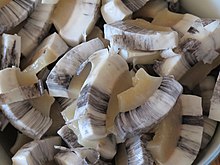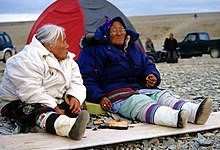
Muktuk (transliterated in various ways, see below) is a traditional food of Inuit and other circumpolar peoples, consisting of whale skin and blubber. A part of Inuit cuisine, it is most often made from the bowhead whale, although the beluga and the narwhal are also used. It is usually consumed raw, but can also be eaten frozen, cooked, or pickled.
Methods of preparation


In Greenland, muktuk (mattak) is sold commercially to fish factories, and in Canada (muktaaq) to other communities.
When chewed raw, the blubber becomes oily, with a nutty taste; if not diced, or at least serrated, the skin is quite rubbery.
One account of a 21st-century indigenous whale hunt describes the skin and blubber eaten as a snack while the rest of the whale meat is butchered (flensed) for later consumption. When boiled, this snack is known as unaaliq. Raw or cooked, the blubber and skin are served with HP Sauce, a British condiment, or soy sauce.
Nutrients and health concerns
Muktuk has been found to be a good source of vitamin C, the epidermis containing up to 38 mg (0.59 gr) per 100 grams (3.5 oz). It was used as an antiscorbutic by British Arctic explorers. Blubber is also a source of vitamin D.
Proceedings of the Nutrition Society stated in the 1950s that:
The most important item of food of the Polar Eskimos is the narwhal (Monodon monoceros). The skin (mattak) is greatly relished and tastes like hazel-nuts; it is eaten raw and contains considerable amounts of glycogen and ascorbic acid. The White whale (Delphinupterus leucas) is almost as important...
Contaminants from the industrialised world have made their way to the Arctic marine food web. This poses a health risk to people who eat "country food" (traditional Inuit foodstuffs). As whales grow, mercury accumulates in the liver, kidney, muscle, and blubber, and cadmium settles in the blubber, the same process that makes mercury in fish a health issue for humans. Whale meat also bioaccumulates carcinogens such as PCBs, chemical compounds that damage human nervous, immune and reproductive systems, and a variety of other contaminants.
Consumption of muktuk has also been associated with outbreaks of botulism.
Spellings
Transliterations of "muktuk", and other terms for the skin and blubber, include:
- Ikiilgin, Chukchi
- Maktaaq (ᒪᒃᑖᖅ), Sallirmiutun (Siglitun), Kivalliq, Aivilingmiutut (Aivilik), North Baffin, East Baffin, South Baffin
- Maktak (ᒪᒃᑕᒃ), Iñupiaq, Sallirmiutun, North Baffin
- Maktaq, Inuinnaqtun, Natsilingmiutut (Inuvialuktun)
- Mattak, Labrador, Greenland
- Mangtak, Alaskan Yupʼik
- Mungtuk, Siberian Yupik
- Kimaq, Alutiiq (Sugpiaq)
In some dialects, such as Inuinnaqtun, the word muktuk refers only to the edible parts of the whale's skin and not to the blubber.
See also
- Nalukataq, spring whaling festival
- Marine mammals as food
- Chukchi cuisine
References
- "muktuk". Asuilaak Living Dictionary.
- Stern, Pamela (2009). The A to Z of the Inuit. Lanham: Scarecrow Press. p. 101. ISBN 978-0-8108-6822-9.
- "10 Weirdest Foods in the World". News.travel.aol.com. 9 September 2010. Archived from the original on 11 September 2010. Retrieved 11 September 2013.
- Heide-Jørgensen, Mads Peter (January 1994). "Distribution, exploitation and population status of white whales (Delphinapterus leucas) and narwhals (Monodon monoceros) in West Greenland". Meddelelser om Grønland, Bioscience. 39: 135–149. doi:10.7146/mogbiosci.v39.142541.
- Hoover C, Bailey M, Higdon J, Ferguson SH, Sumalia R (March 2013). "Estimating the Economic Value of Narwhal and Beluga Hunts in Hudson Bay, Nunavut". The Arctic Institute of North America. 66: 1–16.
- ^ Zellen, Barry Scott (2008). Breaking the ice : from land claims to tribal sovereignty in the arctic. Lanham, MD: Lexington Books. p. 376. ISBN 978-0-7391-1941-9. OCLC 183162209.
- Tusaayaksat – Spring 2015. Tusaayaksat Magazine. 15 April 2015.
- Goward, Sydney (10 August 2021). "Exploring Tuktoyaktuk: Pingos, Muktuk, and the Arctic Ocean". My Site. Retrieved 6 April 2022.
- Boorman ·, Charley (2012). Extreme Frontiers: Racing Across Canada from Newfoundland to the Rockies. Little, Brown Book Group. ISBN 9780748132775.
- Pearce, Tristan (2021). Research with Arctic Inuit communities : graduate student experiences, lessons and life learnings. Cham, Switzerland: Springer. ISBN 978-3-030-78483-6. OCLC 1265523671.
- "Soy Sauce – An essential Inuit condiment". University of Waterloo. 8 July 2024.
- Geraci, Joseph R. & Smith, Thomas G. (1979). "Vitamin C in the Diet of Inuit Hunters From Holman, Northwest Territories" (PDF). Arctic. 32 (2): 135–139. doi:10.14430/arctic2611. JSTOR 40508955.
- Fediuk, K.; Hidiroglou, N.; Madère, R.; Kuhnlein, H. V. (2002). "Vitamin C in Inuit Traditional Food and Women's Diets". Journal of Food Composition and Analysis. 15 (3): 221. doi:10.1006/jfca.2002.1053.
- McClintock, Francis Leopold (2012), "CHAPTER XVI", A Narrative of the Discovery of the Fate of Sir John Franklin and His Companions, Cambridge University Press, pp. 301–322, doi:10.1017/cbo9781139236522.018, ISBN 978-1-139-23652-2
- Kuhnlein, H. V.; Barthet, V.; Farren, A.; Falahi, E.; Leggee, D.; Receveur, O.; Berti, P. (2006). "Vitamins A, D, and E in Canadian Arctic traditional food and adult diets". Journal of Food Composition and Analysis. 19 (6–7): 495. doi:10.1016/j.jfca.2005.02.007.
- Sinclair, H.M. (1953). "The Diet of Canadian Indians and Eskimos". 12. Proceedings of the Nutrition Society: 69–82. doi:10.1079/PNS19530016. S2CID 71578987.
{{cite journal}}: Cite journal requires|journal=(help) - "Country Food (Inuit Food) in Canada | The Canadian Encyclopedia". thecanadianencyclopedia.ca. Retrieved 6 April 2022.
- Wagemann, R.; Snow, N.B.; Lutz, A.; Scott, D.P. (1983). "Heavy Metals in Tissues and Organs of the Narwhal (Monodon monoceras)". Canadian Journal of Fisheries and Aquatic Sciences. 40 (S2): s206 – s214. doi:10.1139/f83-326.
- "Chemical Compounds Found in Whale Blubber Are From Natural Sources, Not Industrial Contamination". 18 February 2005.
- "Japan warned on 'contaminated' blubber". BBC News. 24 January 2001. Retrieved 31 December 2009.
- "Google Scholar". scholar.google.com. Retrieved 18 November 2018.
- Horowitz, B Zane (2010). "Type E botulism". Clinical Toxicology. 48 (9): 880–895. doi:10.3109/15563650.2010.526943. PMID 21171846. S2CID 20417910.
- "maktaaq". Asuilaak Living Dictionary.
- Uqaluktuat: 1980 Elders' Conference, Women's Session ISBN 1-881246-01-9
- "maktak". Asuilaak Living Dictionary.
- ^ Ohokak, G.; M. Kadlun; B. Harnum. Inuinnaqtun-English Dictionary (PDF). Kitikmeot Heritage Society. Retrieved 3 April 2016.
- "maktaq". Asuilaak Living Dictionary.
- "mattak". Asuilaak Living Dictionary.
- Jacobson, Steven A. (2012). Yup'ik Eskimo Dictionary, 2nd edition Archived 3 August 2017 at the Wayback Machine. Alaska Native Language Center.
- "edible whale skin". Asuilaak Living Dictionary.
External links
 Media related to Muktuk at Wikimedia Commons
Media related to Muktuk at Wikimedia Commons
| Edible fats and oils | |||||||||||||
|---|---|---|---|---|---|---|---|---|---|---|---|---|---|
| Fats |
| ||||||||||||
| Oils | |||||||||||||
| |||||||||||||
| Whaling | |
|---|---|
| History of whaling | |
| By country | |
| Harpoons | |
| Hunting type | |
| Implements | |
| Products | |
| Regulations | |
| Sanctuaries | |
| World Eskimo Indian Olympics (WEIO) | |
|---|---|
|